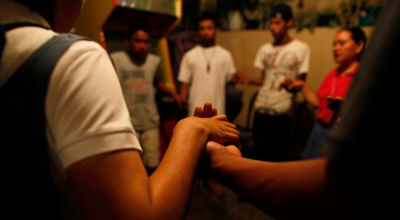AG Hispanic Churches Struggle With ‘Culture Shock’
For many decades, Spanish-speaking Assemblies of God churches could typically be described as predominately Mexican and Mexican-American churches where all services were held in Spanish. Today, some see Hispanic churches as resembling close-knit families who share a similar heritage and culture. For many generations, those descriptions and assumptions would have been mostly correct.
Yet now, to the surprise of even some Hispanic churches, the “melting pot” that is the United States is making itself known and providing a “culture shock” for some Hispanic churches that goes beyond the nearly inevitable clash of generations.
“Just like most churches, Hispanic churches typically minister to several generations within their congregations,” says Efraim Espinoza, director of AG Office of Hispanic Relations. “So, they have the expected generational differences to work through.”
However, Espinoza adds that unlike most Anglo churches, what many Hispanic churches are experiencing is the growth in the numbers of Spanish-speaking members who are not from Mexico, but come from other Latin-American countries.
New Dawn Worship Center/Centro de Adoración Nuevo Amanecer (AG), a member of the Northern Pacific Latin American District of the Assemblies of God, in Fremont, Calif., is one of those churches.
Maynor Morales, who has led New Dawn (currently 120 members) for the past 14 years with his wife, Evelyn (who is also an ordained AG minister), explains that the church has experienced several transitions, evolving to meet the needs of a changing congregation. But it’s not always an easy road to navigate.
“When I first got here, we had two congregations: one Spanish and one English,” Morales says. “But as time went by, we had more second- and third-generation Mexican and Mexican-Americans [individuals who speak fluent English] as well as more first-generation members from Central and South America, so now we have a bilingual service [the service is translated].”
Morales explains that this mix of generations, languages and now very different cultures requires constant self-vigilance on the part of church leaders.
“What some people don’t realize is that there are some important differences in the Spanish language Mexican-Americans speak and the Spanish of countries in Central and South America,” Morales says, implying how someone could be unintentionally offended.
But where things can get really sticky is in cultural differences. “The cultures of those of Mexican descent, Mexican-America descent, Central American and South American descent have few similarities outside of the language,” Morales says. “Each country has its own traditions and expectations. We do our best to not only learn, but be sensitive to cultural and generational differences. We also alter our services a bit from week to week to minister more effectively to the entire church body.”
But ministry challenges aren’t just with adults. Eva Hinojoza, who has been teaching Sunday school for 25 years at New Dawn, explains that although the main services are translated, what some people may find surprising is that children’s Sunday school is always in English. Hinojoza explains that children must learn English in order to do well in school and to communicate outside of the Spanish-speaking community.
Yet, keeping in mind that there are multiple cultures in her classroom, which can include “first-generation” children who don’t speak any English as well as children transitioning from Spanish to English as a “first” language, Hinojoza says she has discovered the key to her success is the curriculum.
“Some of my children need to learn English or are not fluent in English, so we read the Sunday school lesson together,” Hinojoza says. She explains that the Sunday school lesson becomes almost like an ESL (English as a Second Language) course for kids, but as the church uses Radiant Life Curriculum, it comes with a powerful Pentecostal message.
“As we read, the kids always have questions,” Hinojoza says. “So not only are they learning English, but they’re learning about God’s Word—and they’re responding to it. I’ve seen lives change and God work in kids’ lives through the materials … and they have developed a hunger to learn more.”
Hinojoza’s husband and daughter also teach Sunday school classes, and they both use the English Radiant Life materials with great success in their classrooms, despite the cultural differences and
challenges. “My daughter [a recent graduate of Vanguard University] absolutely loves the materials provided,” Eva Hinojoza says.
As more Hispanic churches become more fully “Latino-American” churches—encompassing Spanish- and English-speaking generations from North, South and Central America as well as Spain—New Dawn Center, Morales and the Hinojozas already understand the challenges and rewards of this multicultural culture.
“Some weeks, our services are more Anglo; some weeks, more of a Latino mix,” Morales says, “but we work to offer something to the different culture groups. Our children and youth also need that accommodation. We don’t want to run the risk that they don’t feel ministered to, either. We intentionally minister to our members in their own language and own culture, not just first generation, but second, third and fourth.”














































